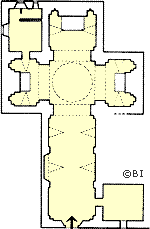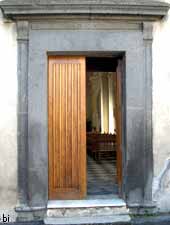|
The small belfry is located above the left nave, along the border looking on Santa Caterina street.
The inside
 The interior is in the shape of a Latin cross, with a nave, with adjacent appurtenances; the design, clean and linear, is enlivened by the score of the pilasters and the simple overhanging frames. The interior is in the shape of a Latin cross, with a nave, with adjacent appurtenances; the design, clean and linear, is enlivened by the score of the pilasters and the simple overhanging frames.
The church has three well-made altars covered in polychrome marble: on the right the altar dedicated to the Assumption (where there was a beautiful painting of the Virgin, unfortunately stolen a few decades ago), on the left that of the martyrdom of St. Bartholomew (of end of 1800, probably erected in honor of one of the founders of the church, the saint Bartolomeo Vellina) and that of Santa Caterina (which until a few years ago was placed on the main altar).  The canvas, in such a poor state of preservation that it is difficult to read, represents the mystical wedding of the Saint with Jesus in the presence of the Virgin, the Apostles and the Saints. On the floor of the church, at the beginning of the central nave, there is a fairy marble plaque carved in relief with floral ornaments and figures. The canvas, in such a poor state of preservation that it is difficult to read, represents the mystical wedding of the Saint with Jesus in the presence of the Virgin, the Apostles and the Saints. On the floor of the church, at the beginning of the central nave, there is a fairy marble plaque carved in relief with floral ornaments and figures.
The following writing is carved into a panel: «Hic jacet corpus Abatis Regii S. T. D. D. Marii Philippi Fallico Consultoris et Qualificazioneris S. Officij in hoc Sicilić Regno, Beneficialis ac Benefactoris Hujus Aecclesić S. Catharinć Senensis. Obiit die primo Aprilis 1768."  Apart from the date of his death, it was not possible for us to know anything about this Mario Filippo Fallico, abbot and "benefactor" of the small church of Santa Caterina. Apart from the date of his death, it was not possible for us to know anything about this Mario Filippo Fallico, abbot and "benefactor" of the small church of Santa Caterina.
Among the precious objects of a religious and ceremonial nature owned by the church until a few decades ago (reliquaries, chalices and monstrances from various periods) we show you an embossed, chiselled and perforated silver thurible by Bartolomeo Bartolotta (1753) decorated with floral motifs. |